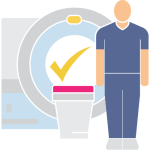Copay
A fixed cost you need to pay for certain medical services, usually at the time of service. Office visits and prescription medicine often require copays.
Example:
A visit to the family doctor may require a $25 copay, while an emergency room visit may involve a larger copay as well as have costs that are applied to your deductible and/or coinsurance. Pharmacy prescriptions often have a copay, while radiology services typically do not. Some services require both a copay and coinsurance.
Coinsurance
The medical expenses you pay after your insurance has paid its portion of the bill. Coinsurance begins after you meet your deductible and is usually a percentage of the amount your insurance pays.
Example:
You've reached your deductible for the year and have an MRI. The cost is $2,000. If your coinsurance is 20 percent, that means you will be responsible for 20 percent of that $2,000 bill, or $400.
Deductible
The amount of money you pay out of pocket each year before your insurance will begin covering expenses. Deductibles usually start over at the beginning of each calendar or fiscal year. Nearly 80% of patients do not meet their annual deductible. If you fall into that statistic, and you need imaging, consider our flat rate prices.
Example:
If you have a $2,000 deductible, you pay the first $2,000 of your own medical expenses. This is called meeting your deductible. After that, your insurance will pay some of your medical expenses. You may still have to pay a portion of your expenses through copays and coinsurance.
Health Savings Account
These pre-tax contributions are commonly offered with a high deductible insurance plan and can be used for qualified medical expenses. Unused funds roll over from year to year and are available even if your insurance or employment changes. HSA plans are becoming a popular way to save and pay for healthcare costs. You may also use your HSA to pay for a flat rate imaging service.
Allowable vs. billed charges
The allowable charge is the amount of compensation your insurance company and provider agree to for medical services. A bill is paid in full when the allowable charge is paid plus any copay or coinsurance. The allowed amount also determines how much you pay in coinsurance. The billed charge is usually higher than the allowed charge.
In-network vs.
out-of-network providers
In-network providers, also known as preferred providers, are clinics and physicians that agree to a fixed rate with your insurance company. Out-of-network providers have not agreed to fixed rates, which allows them to be flexible with what they charge you. Call around and get estimates for flat rate pricing before choosing a provider. Mountain Medical’s flat rate pricing maybe your best option, even if we are out-of-network, you may end up paying less.
Preauthorization
(prior approval or precertification)
Some medical procedures require your insurance company's approval beforehand, called preauthorization. If preauthorization is required, but not received, your insurance may deny benefits. To be sure you're covered, always contact your insurance before moving forward with a treatment or procedure.
Flat Rate Prices
A set price for services. Flat rate prices are helpful for patients who are uninsured. They also save money on out-of-pocket expenses for nearly 80% of patients who will not meet their annual deductible. If you have a high deductible that you are not likely to meet it in the calendar year, AND you are willing to not have your insurance billed, then a flat rate price could save you hundreds of dollars. Additionally, when choosing flat rate pricing, you do not need to worry if you are getting services from an in-network or out-of-network provider. Mountain Medical’s flat rate prices include:
- $540 MRI/MRA (arthrogram has additional fee)
- $380 CT/CTA (Coronary Calcium Scoring $85)
- $250 Ultrasound
- $80 X-ray
Example:
Your doctor orders a CT scan to rule out an appendicitis. Your insurance plan has a high deductible of $2,000, before your coinsurance of 20% kicks in. Last year you did not hit your deductible and you do not anticipate hitting it this year. Skipping your insurance and paying the flat rate price of $380 could save you as much as $500!
Estimate
We can help you estimate your deductible and coinsurance or copays and determine if our flat rate pricing is a better fit for your budget!
801-713-0600
Copay
A fixed cost you need to pay for certain medical services, usually at the time of service. Office visits and prescription medicine often require copays.
Example:
A visit to the family doctor may require a $25 copay, while an emergency room visit may involve a larger copay. Pharmacy prescriptions often have a copay. Some services require both a copay and coinsurance.
Coinsurance
The medical expenses you pay after your insurance has paid its portion of the bill. Coinsurance begins after you meet your deductible, and is usually a percentage of the amount your insurance pays.
Example:
You've reached your deductible for the year and have an MRI. The cost is $1,000. If your coinsurance is 20 percent, that means you will be responsible for 20 percent of that $1,000 bill, or $200.
Deductible
The amount of money you pay out of pocket each year before your insurance will begin covering expenses. Deductibles usually start over at the beginning of each calendar or fiscal year.
Example:
If you have a $1,000 deductible, you pay the first $1,000 of your own medical expenses. This is called meeting your deductible. After that, your insurance will pay some of your medical expenses. You may still have to pay a portion of your expenses through copays and coinsurance.
Health Savings Account
These pre-tax contributions are commonly offered with a high deductible insurance plan and can be used for qualified medical expenses. Unused funds roll over from year to year and are available even if your insurance or employment changes. HSA plans are becoming a popular way to save and pay for healthcare costs.
Allowable vs. billed charges
The allowable charge is the amount of compensation your insurance company and provider agree to for medical services. A bill is paid in full when the allowable charge is paid plus any copay or coinsurance. The allowed amount also determines how much you pay in coinsurance. The billed charge is usually higher than the allowed charge.
In-network vs.
out-of-network providers
In-network providers, also known as preferred providers, are clinics and physicians that agree to a fixed rate with your insurance company. Out-of-network providers have not agreed to fixed rates, which allows them to be flexible with what they charge you. Call around and get estimates before choosing a provider. You may end up paying less.
Preauthorization
(prior approval or precertification)
Some medical procedures require your insurance company's approval beforehand, called preauthorization. If preauthorization is required, but not received, your insurance may deny benefits. To be sure you're covered, always contact your insurance before moving forward with a treatment or procedure.
Call for an out-of-pocket estimate and appointment today!
With Mountain Medical you can afford both
Quality imaging

and

BIG
savings
When your doctor orders an MRI, CT scan or ultrasound ask to have it done at Mountain Medical Imaging. You’ll breathe easier knowing you kept more money in your pocket.
5323 S. Woodrow Street
Salt Lake City
1486 E. Skyline Drive
South Ogden

